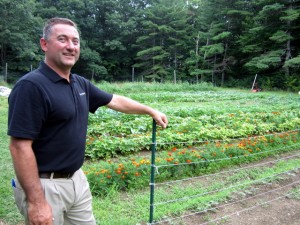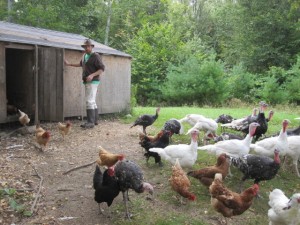The Bon Appétit Dream Comes Alive at Saint Joseph’s College of Maine
The “Dream” is a big concept at Bon Appétit: both in terms of the dream itself and the company wide buy-in to the concept. At first, the language struck me as somewhat stiff, but as I visit our cafés along the east coast, the reality of it comes to life for me over and over again.
Saint Joseph’s College of Maine in Standish, ME, was one such visit. Under the leadership of General Manager Stuart Leckie and Executive Chef Christian Bassett, the team at Saint Joseph’s takes what Bon Appétit requires nationwide in terms of social and environmental commitments (no small feat), and pushes each as far as they are able.
Like all Bon Appétit kitchens, they make soups, stocks, sauces, and dough from scratch. But Saint Joseph’s doesn’t stop there – they also make items like peanut butter and ketchup from scratch. (I didn’t even know you could make ketchup from scratch!)
A few years ago, the Bon Appétit team was also integral in starting a farm on campus. The Pearson Town Farm now comprises more than four acres, composts all of the food waste from the school, and provides vegetables, herbs, turkey, and even lamb to the chefs. Farm Manager Michial Russell has worked hard to weave the farm into the threads of the community. Students log work hours on the farm through an ecology course that every undergraduate is required to take. This means every student at Saint Joseph’s College of Maine spends a minimum of four hours physically involved in the process of growing their food, regardless of their course of study.
The first students to get involved on the farm were nursing students, who came out to help deliver the baby lambs. Now, students raise turkeys that are eaten on campus during the annual Thanksgiving celebration. They even have the opportunity to slaughter the turkeys themselves if they want to participate in the process.
Michial uses principles of permaculture to decide what and how to grow. In permaculture, everything has at least two purposes. The bright marigolds are there not only to look pretty but to attract beneficial insects and repel harmful ones. The chickens were brought onto the farm to alleviate a pesky tick population and now provide eggs to the farm’s Community Supported Agriculture members – mostly faculty and staff, who pay in the spring for a share of the upcoming season’s bounty.
Each row of the garden has two to four different types of plants, selected because they don’t compete with one another – either because they use different soil nutrients at different times or complement each other in terms of physical structure (deep-rooted plants go well with plants that have roots along the surface; tall plants, such as corn, go well with plants that spread out and provide ground cover, such as beans, and so on).
These examples barely scratch the surface of the creativity and dedication I experienced from the Bon Appétit team at Saint Joseph’s College of Maine, but they led me to an interesting revelation: the Bon Appétit Dream isn’t just that our food is phenomenal, made from scratch and sourced according to exemplary social and environmental standards. Or that Stuart and his team are given the independence to manage the café how they dream, within the context of the community they are a part of.
For me, it’s that this all happens as one piece of a larger network that provides a high floor in terms of quality and social and environmental commitments – but also offers the resources and flexibility employees need to push the ceiling as high as it will go. And push they do!

